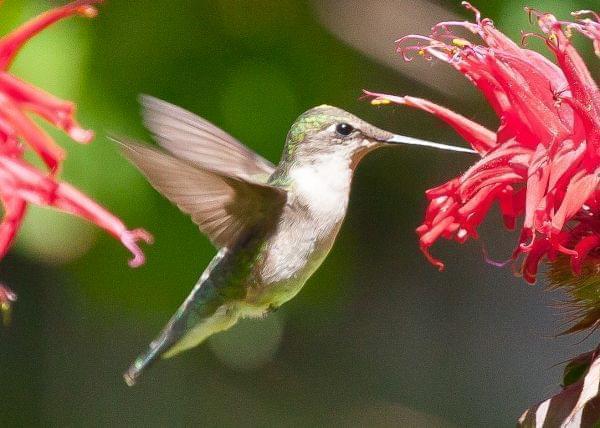Appreciating Hummingbirds in Illinois

A female ruby-throated hummingbird nectaring on bee balm in a garden. Rob Kanter
More often than not, when I try to point out hummingbirds to other people, I wind up gesturing toward air. “Hey, guys,” I call, “come see the hummingbird at the . . . oh, never mind.”
That said, the months of August and September provide some of the year’s best opportunities for observing hummingbirds in Illinois. That’s because individuals that have been farther north during the breeding season collect here on their way south.
When I say, “hummingbird,” here I mean “ruby-throated hummingbird,” which is the only species from this family of birds that breeds east of the Mississippi, and the only one commonly seen in Illinois.
All ruby-throats are an iridescent green on the back, and whitish in front, with only adult males sporting the ruby red throat that gives the species its name. (To further confuse the issue, those throat feathers appear red only when the light hits them from a certain angle.)
Hummingbirds are perhaps most remarkable for how small they are compared to other birds. Ruby throats are shorter than 4 inches from bill to tail tip, and weigh just three and a half grams. That’s comparable to three and a half grapes, or about midway between the weights of a penny and a nickel.
Despite their small size, many hummingbirds migrate over long distances. Ruby throats heading south may travel 2000 miles to reach their winter territory in southern Mexico and Central America, including a 500-mile nonstop leg of the trip over the Gulf of Mexico. Hummingbirds are also remarkable for their agility in flight. With wings that beat 53 times a second, they can hold themselves perfectly still in front of a flower, then zip off in any direction—up, down, sideways, or even backwards.
Most people are aware that hummingbirds feed on nectar, which they obtain with their elongated bills. But nectar represents only half of the ruby throat’s diet. The other half is insects. Ruby throats most often catch bugs by “hawking” them, which is to say they wait on an open perch for prey to come by then fly out to grab it from the air. Ruby throats also pick insects and spiders off of trees and flowers, a behavior known as “gleaning.”
People who observe hummingbirds are often struck by how combative they are, despite their delicate appearance. Even where there are multiple sources of food and plenty of perches, hummingbirds chase each other off like lions at a kill.
The easiest way to attract hummingbirds to your yard is to provide food for them. In the long term, you can do this by planting native perennials such as columbine and bee balm, or, better still, trumpet vine, which is a hummingbird favorite with its 3-inch long scarlet flowers. For a quicker fix, you can simply put up a hummingbird feeder filled with either commercial imitation nectar or a 20-percent solution of sugar water, for which recipes are widely available in birding books and on the web.
